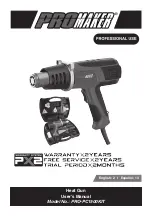
1. Clamp in the desired cutter (see chapter
7.2., „Insertion and replacement of the
mill cutter router bit“)
2. Pull out lock-on lever 1; the spring pre-
load presses the foot into its lowest posi-
tion.
3. Press milling-cutter head 2 into the
guides against the spring force to a posi-
tion corresponding to the desired milling
height or put the cutter with base plate 3
on the edge of a slab (4) (or similar) and
place milling-cutter head 2 with pulled
lock lever 1 into both columns to the
desired depth.
4. The height is fixed when locking lever 1 is
folded back.
7.3.2 Milling depth adjustment
(Fig. 5):
The milling depth adjustment is used for final,
precise adjustment of the milling height. Using
setscrew 1, the desired height change can be
made exact by turning it back and forth.
1. Clamp in the desired cutter (see chapter
7.2., „Insertion and replacement of the
mill cutter router bit“)
2. Pull out locking lever 3 and place the mill
cutter router bit with base plate 6 on a
stable support.
3. Carefully press the cutter against the
spring force until the nip of the cutter
lightly touches the surface of the sup-
porting surface (see Fig. 5, left picture).
4. Now turn setscrew 1 toward the bottom
until it „sits“ on limit-stop post 4 in the
milling cutter.
5. The knurl and mill cutting position is now
„zeroed“, so to say. Now just let go of the
mill cutter router bit and turn the
setscrew on its thread toward the top up
to the desired depth (see 2nd picture,
center). Please use scale 5 for orienta-
tion: One entire rotation of the setscrew
is equivalent to one millimeter height dif-
ference.
6. Now push base plate 6 against the spring
force so far in until the limit stop on
setscrew 1 „sits“ (see 3rd picture, right).
The mill cutter router bit is now set deep-
er than the bottom of base plate 6 by the
amount of the value set in step 5. I.e.,
this value is also the depth of the groove
that you can now mill out.
7. Fold locking lever 3 back.
The milling height has now been adjusted.
7.4 Suction device (fig. 3)
Your surface miller comes equipped with a
suction device. It is recommended to use it
not just because of the desired cleanliness
at the work area:
when working with certain types of wood or
other materials, harmful or explosive dusts
can arise. In the interest of your own health,
work only with the suction device connected
and always wear a dust protection mask in
addition. Make sure you use a vacuum
cleaner that is suitable for the accruing dust.
1. Plug flexible suction hose 1 onto connec-
tion 2
2. Connect flexible suction hose 1 using
rubber adapter 3 to the vacuum cleaner
hose.
When working with the vacuum cleaner, it is
recommended you to use the PROXXON
AS/E suction controller device.
7.5 Milling
7.5.1 General information on milling
• When working with the surface miller, use
both hands to guide the switched-on de-
vice over the work piece. Always work in
the opposite direction of the cutter rota-
tion (see figure 6). The rotating mill cutter
router bit must always run with its cutting
edge against the milling movement.
• Otherwise, there is a risk that you will
end up with poor milling work, cannot
cleanly guide the device, or even that it
leaps out of your hand.
• Pay attention that the milling depth is not
set too deep! Always set the milling
depth to match the type of mill cutter
router bit and the material to be milled.
• Too deep a mill setting and too great a
feed rate lead to poor milling results and
unnecessarily stresses the machine’s me-
chanics! It is better to carry out several
milling passes. Also, readjust the limit
stop or the cutter height often.
• Always constrain or tightly clamp the
work piece!
13
Содержание MICRO-Router MOF
Страница 1: ...ProxxonTools com MICRO Router MOF Manual ...
Страница 2: ...Notes 2 ...
Страница 3: ...3 8 8 Fig 1 Fig 2 Fig 5 Fig 4 Fig 3 ...
Страница 4: ...4 0 10 20 30 Fig 6 Fig 7a Fig 7b Fig 8b Fig 8a ...
Страница 5: ... 3 2 1 Fig 11 Fig 13 5 0 10 20 30 0 10 20 30 0 10 20 30 Fig 9 Fig 10 Fig 12 ...


































